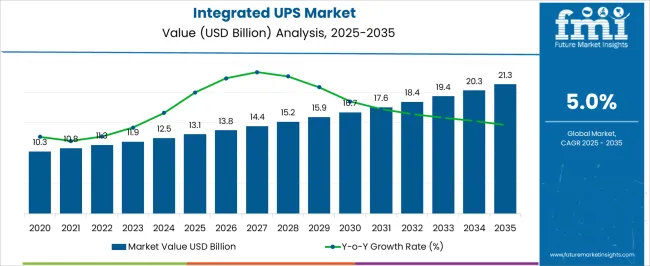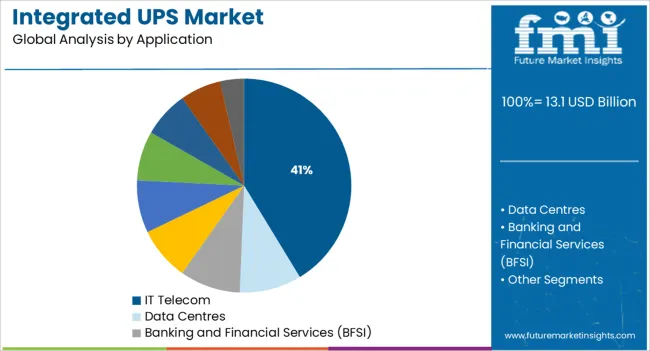The Integrated UPS Market is estimated to be valued at USD 13.1 billion in 2025 and is projected to reach USD 21.3 billion by 2035, registering a compound annual growth rate (CAGR) of 5.0% over the forecast period.

| Metric | Value |
|---|---|
| Integrated UPS Market Estimated Value in (2025 E) | USD 13.1 billion |
| Integrated UPS Market Forecast Value in (2035 F) | USD 21.3 billion |
| Forecast CAGR (2025 to 2035) | 5.0% |
The integrated UPS market is gaining momentum as industries prioritize uninterrupted power solutions to safeguard critical infrastructure against increasing grid instability and power quality fluctuations. The rapid expansion of data centers, cloud computing services, and industrial automation has created demand for compact high performance power backup systems with seamless integration capabilities.
Businesses are increasingly investing in energy efficient and modular UPS systems that offer scalability, real time monitoring, and compatibility with renewable energy sources. Regulatory emphasis on operational continuity, data security, and equipment protection in sectors such as healthcare, telecom, and finance is accelerating adoption.
The outlook remains strong as digital transformation and remote operations continue to fuel demand for reliable power protection solutions across enterprise and industrial settings.
The market is segmented by 10 kVA -100 kVA and Application and region. By 10 kVA -100 kVA, the market is divided into 100 kVA -250 kVA and 250 kVA and above. In terms of Application, the market is classified into IT Telecom, Data Centres, Banking and Financial Services (BFSI), Defence, Commercial and Infrastructure, Healthcare, Energy, Media Entertainment, and Others (Other Industrial Solution). Regionally, the market is classified into North America, Latin America, Western Europe, Eastern Europe, Balkan & Baltic Countries, Russia & Belarus, Central Asia, East Asia, South Asia & Pacific, and the Middle East & Africa.
The 10 kVA to 100 kVA segment is expected to account for 48.60% of the total revenue by 2025, making it the dominant category within the power range segment. This growth is supported by rising demand from mid sized enterprises, commercial buildings, and edge computing sites that require compact and efficient power backup systems.
These systems offer a balance between performance and cost, making them ideal for distributed networks and facilities with moderate load requirements. Their scalability, ease of installation, and integration with monitoring systems have further strengthened their adoption.
As operational uptime and equipment protection become business imperatives, this power range continues to attract high adoption in growing digital and hybrid infrastructures.

The IT and telecom segment is projected to hold 41.30% of total market revenue by 2025, positioning it as the leading application segment. This is driven by the exponential growth in data consumption, cloud based services, and digital connectivity infrastructure requiring continuous and reliable power supply.
Data centers, telecom towers, and switching hubs are highly sensitive to power fluctuations, making integrated UPS systems critical to maintaining service availability and minimizing downtime. The segment is also benefitting from the rollout of 5G networks and expansion of rural connectivity programs which demand robust power continuity solutions.
Given the sector’s critical dependence on uninterrupted power, IT and telecom remain at the forefront of integrated UPS system deployment.
The integrated UPS market is witnessing a considerable surge in market shares over the recent few years. Owing to the facility of redundant power protection and flexible adaption to power, UPS are having high application across diverse factories. It is analyzed that automation facilities are stirring up the demand for integrated UPS across the globe.
Due to the high employment of UPS systems in the industrial sector, the market shares are likely to surpass a valuation of approximately USD 14 Billion in the upcoming 5 years. The demand to protect the systems from disruptions at instances of voltage transients and power outages is identified as a key growth propellant in the integrated UPS market.
The integrated UPS systems are making allowance for industries to reach the exact power requirements. The surge in expenditures made by the IT sectors across the developing countries and growth in the number of data centers are resulting in higher sales of computers, which in turn is expected to fuel the sales of integrated UPS systems in the forthcoming years.
Furthermore, simple maintenance and easy installation facilities, and delivery of power without breaks for extended periods are likely to lead to accruing more market shares through 2035. Although the market is having healthy growth, the initial installation charges involved and the cost of energy can serve as major restraints in the long run.
In addition to that, small-scale industries across the globe are lacking awareness about integrated UPS systems over conventional UPS. It is identified that departmental stores, education centers, and various start-ups are making a considerable contribution to the growth of the market. Owing to the rise in demand for data management, the key manufacturers in the integrated UPS industry are expanding their production capabilities to upkeeping up with the market demand.
Due to the existence of numerous international and regional companies, the market for integrated UPS is very competitive. To strengthen their position in the market, major players are implementing a variety of methods, including product portfolio growth and regional development. The key players are adopting various business strategies, such as mergers and acquisitions, to expand their geographic presence and consumer base across the world. Therefore, the market is projected to register significant growth through the forecast period.
The growing need of high-end industrial UPS systems in niche industrial applications is pushing the end users to invest in and deploy high end integrated industrial UPS systems, subsequently growing the global integrated UPS market. The demand is growing in industrial niche applications and is one of the biggest driver for the increasing demand of the integrated UPS and global integrated UPS market dispersion.
In addition, increasing IT spending and growing data centres worldwide coupled with continuing growth in PC sales in the APAC region, is boosting demand for UPS systems, globally and facilitating integrated UPS market growth.
The additional benefits such as easy installation and maintenance, delivery of true sine wave power without breaks for extended periods, or continuous filtering of surges and transients for supplying clean electricity and can be some of the drivers for the global integrated UPS market.
Despite of being simple, compact, robust and reliable source of power the integrated UPS suffers from some challenges such as cost requirements such as startup cost and energy cost can restrain the global integrated UPS market from growing.
The global integrated UPS market is projected to register a favourable growth for the forecast period, 2020?2025. APAC is projected to withstand its control on the global integrated UPS market. The widening energy demand-supply gap is expected to increase UPS adoption, in APAC countries, over the next five years, which will result in growing integrated UPS market globally.
The region is anticipated to uphold its dominance in the global integrated UPS market due to consistently growing demand for UPS systems from developing economies such as China and India. North American and Europe is expected to follow the Asia market in terms of growth in global integrated UPS market.
Some of the key market participants in global integrated UPS market are TEAL Electronics, ABB, Emerson Electric, Huawei, GE, Schneider Electric among others.
The research report presents a comprehensive assessment of the market and contains thoughtful insights, facts, historical data, and statistically supported and industry-validated market data. It also contains projections using a suitable set of assumptions and methodologies. The research report provides analysis and information according to categories such as market segments, geographies, types, technology and applications.
The report is a compilation of first-hand information, qualitative and quantitative assessment by industry analysts, inputs from industry experts and industry participants across the value chain. The report provides in-depth analysis of parent market trends, macro-economic indicators and governing factors along with market attractiveness as per segments. The report also maps the qualitative impact of various market factors on market segments and geographies.
The global integrated UPS market is estimated to be valued at USD 13.1 billion in 2025.
The market size for the integrated UPS market is projected to reach USD 21.3 billion by 2035.
The integrated UPS market is expected to grow at a 5.0% CAGR between 2025 and 2035.
The key product types in integrated UPS market are 100 kva -250 kva and 250 kva and above.
In terms of application, it telecom segment to command 41.3% share in the integrated UPS market in 2025.






Full Research Suite comprises of:
Market outlook & trends analysis
Interviews & case studies
Strategic recommendations
Vendor profiles & capabilities analysis
5-year forecasts
8 regions and 60+ country-level data splits
Market segment data splits
12 months of continuous data updates
DELIVERED AS:
PDF EXCEL ONLINE
Integrated Traffic System Market Size and Share Forecast Outlook 2025 to 2035
Integrated Chemistry Systems Market Size and Share Forecast Outlook 2025 to 2035
Integrated Mineral Analyzer Market Size and Share Forecast Outlook 2025 to 2035
Integrated Motor Protector Market Size and Share Forecast Outlook 2025 to 2035
Integrated Universal Integrated Circuit Card (iUICC) Modules Market Size and Share Forecast Outlook 2025 to 2035
Integrated SIM (iSIM) Market Size and Share Forecast Outlook 2025 to 2035
Integrated 3D Radar Market Size and Share Forecast Outlook 2025 to 2035
Integrated Labeling System Market Size and Share Forecast Outlook 2025 to 2035
Integrated Quantum Optical Circuits Market Size and Share Forecast Outlook 2025 to 2035
Integrated Graphics Chipset Market Analysis by Device Type, Industry Vertical, and Region – Growth, Trends, and Forecast from 2025 to 2035
Integrated Food Ingredients Market Analysis -Size, Share & Forecast 2025 to 2035
Integrated Gas System Market Growth – Trends & Forecast 2025 to 2035
Integrated Passive Devices (IPDs) Market
Integrated CMOS Tri-gate Transistor Market
AI-Integrated Blood Analyzers Market Analysis - Size, Share, and Forecast Outlook 2025 to 2035
Drug Integrated Polymer Fibers Market Size and Share Forecast Outlook 2025 to 2035
RFID-Integrated Smart Packaging Market Analysis - Size, Share, and Forecast Outlook 2025 to 2035
Fully Integrated Dishwasher Market Size and Share Forecast Outlook 2025 to 2035
Power Integrated Modules Market Trends – Growth & Forecast through 2034
Memory Integrated Circuits (IC) Market Growth - Trends & Forecast 2025 to 2035

Thank you!
You will receive an email from our Business Development Manager. Please be sure to check your SPAM/JUNK folder too.
Chat With
MaRIA